| FAQ |
Introduction
To help with teacher-examiner workload and to ensure our commitment to working more digitally, we have developed an online way for centres to submit their candidate speaking recordings to Pearson.
The system is called the digital Learner Work Transfer (LWT) portal. Audio files for all language qualifications must now be submitted via this portal, which is available to access through Edexcel Online (EOL). Submissions using USB / CDs will no longer be accepted. Please contact our customer services team if you need support with the LWT portal.
Please note that you should always keep a copy of your candidates’ recordings and paperwork. Pearson may request a copy of the candidates' work if there are any issues with the recording or paperwork uploaded onto LWT.
|
Key dates and deadlines
The speaking assessment windows for the May/June 2026 series are as follows:
- International GCSE Chinese, French, German, Spanish and English as a Second Language: 23 March - 1 June 2026.
- International GCSE Swahili (optional speaking components): 23 March - 1 June 2026.
- International AS/A level French, German and Spanish: 16 April - 21 May 2026.
Speaking dates for future series will be available once they are confirmed in the key dates finder and on the languages landing page.
All speaking recordings should be submitted via our online Learner Work Transfer (LWT) platform within 2 working days of completing the oral examinations for that language qualification in your centre.
|
Documents and file naming conventions
Documents
Centres must submit the following documents for each candidate. Where signatures are required, names can simply be typed on the on-screen forms – there is no need to print, sign manually and scan the forms.
- For International GCSE Chinese, French, German and Spanish:
- Candidate recording
- Candidate cover sheet (CCS)
- Picture used for task A, picture-based discussion, in digital or scanned form (if a candidate has chosen a personal photo, a written description of the picture may be provided instead).
- For International GCSE English as a Second Language (ESL) (4ES1 old specification):
- For International GCSE English as a Second Language (ESL) (4WES4/01 New Specification):
- For International GCSE Swahili (optional centre-assessed speaking endorsement):
Please note: For International GCSE Swahili, submission is only required if a sample of recordings or all recordings are requested for external monitoring.
Please also refer to the submission arrangements for oral recordings guide; this includes complete guidance on the documentation required to be submitted to Pearson.
Please remember that we will NOT be sending hard copy registers or address labels out for these units, as they are all submitted via LWT.
|
File naming conventions
When you create a file for each sampled student, then each file should use the following naming convention:
[centre #]_[candidate number #]_[surname]_[first letter of first name]
For example, Jane Smith, with candidate number 7890 at centre 12345, would have work in a folder titled: 12345_7890_Smith_J
If you are uploading more than one document for a student, please adopt the following naming approach:
International GCSE candidate:
- 12345_7890_Smith_J (for the speaking recording itself)
- 12345_7890_Smith_J_CCS (for the candidate cover sheet)
- 12345_7890_Smith_J_pic (for the candidate’s chosen picture for task A)
IAS/IAL candidate:
- 12345_7890_Smith_J (for the speaking recording itself)
- 12345_7890_Smith_J_OR1 (for the oral topic form for IAS/IAL)
- 12345_7890_Smith_J_CAS (for the candidate authentication sheet)
|
|
Recording formats
Pearson Edexcel only accepts recordings in the following formats:
.mp3
|
.wav
|
.m4a
|
.wma
|
.aif
|
.aiff
|
.mpeg
|
.vlc
|
.ogg
|
.oga
|
.mid
|
.midi
|
If centres record the oral assessment in a different digital format, they must convert the recording to one of the above-accepted formats before submitting them to Pearson Edexcel.
Complete, unedited recordings of all assessments must be submitted to Pearson Edexcel via the LWT. There is no need to encrypt the files you are uploading as the LWT portal is secure. Please do not use zip files.
|
Data protection and privacy
The LWT portal is secure, so there is no need to encrypt the files you are uploading.
|
How to use the LWT Portal to submit oral assessments
If you need further support, step-by-step guidance and screenshots are provided below.
If you have any issues with the LWT system, please create a case.
1. Accessing the portal
Access the portal through your Edexcel Online account under 'Learner Work Transfer':

An example of the Learner Work Transfer dashboard is shown below. Depending on the state of the request ('To Do', 'In Progress' or 'Completed'), the default view will start on a particular tab:
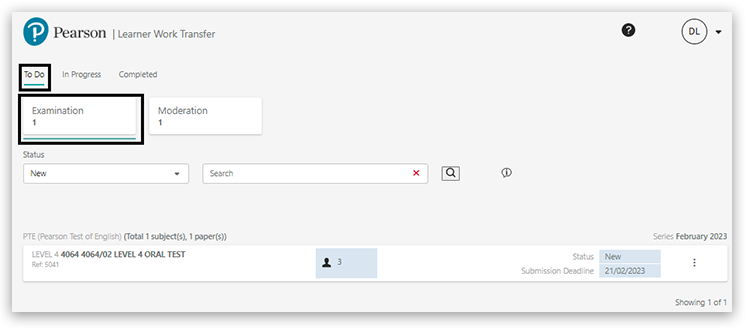
|
2. Viewing candidates in the portal
The search box can be used to narrow down the results as required. Click the three vertical dots on the right of the request, then 'View' learners to open the request:
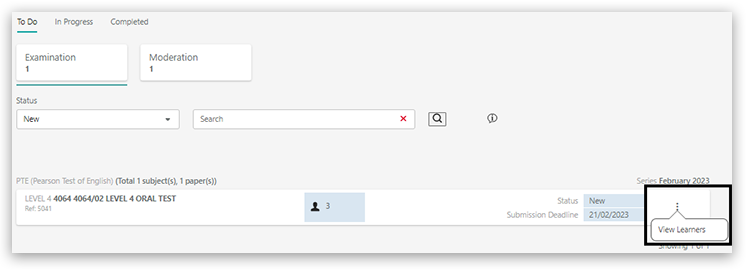
You will be presented with a list of all learners entered for the unit. If you have additional learners who have not yet been entered, please make entries for them through the usual process. This should be updated within 24 hours. If you have uploaded evidence for some learners, when the new entries have been added, the request will show a status of 'In Progress (C)' to represent a change.
|
3. Naming documents for upload
When you create a file for each sampled student, then each file should use the following naming convention:
[centre #]_[candidate number #]_[surname]_[first letter of first name]
For example, Jane Smith, with candidate number 7890 at centre 12345, would have work in a folder titled: 12345_7890_Smith_J
More details on naming individual documents are above.
If you are uploading one CAS form for multiple candidates, please use the following naming convention: [centre number]_CS4, i.e. 12345_CS4. Please see the instructions on linking a file to multiple learners below.
|
4. Uploading files
To upload learner evidence, click 'Browse' under the learner:

This will open a file explorer. Click on a file to upload or hold down the CTRL key to select multiple files, then click 'Open':
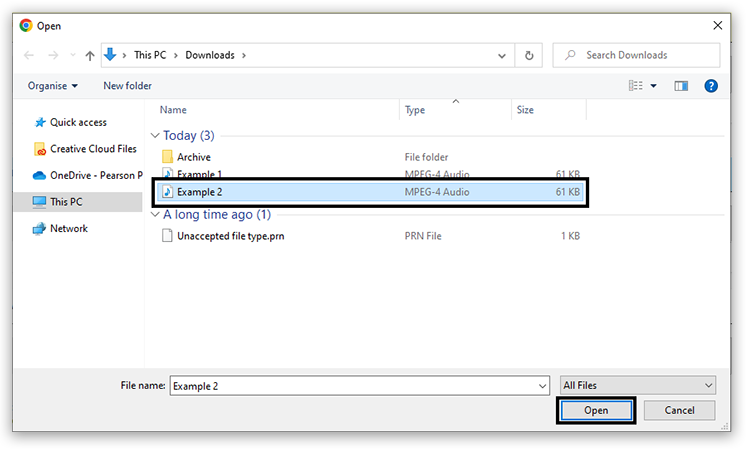
Alternatively, drag the files from your computer onto the grey area of the page, where it states: 'Drop files here':

Files uploaded will display an 'Uploaded' state:

Once the checks are successful, it is updated to ‘Accepted’ or ‘Rejected’. If you have uploaded the incorrect document, you can remove it by clicking the 'X' next to the file name:


Please do not zip files. You can hold CTRL down whilst selecting multiple files in the file explorer if you wish to upload multiple files for a single student in one go. LWT is a secure platform, so there is no need to encrypt files.
The portal accepts the most popular file types, including mp3, mp4 and jpeg files. A complete list of accepted file types.
For any learners who were absent for the assessment, the centre should change their status to 'Absent' using the 'Status' dropdown. This will take the place of completing the attendance register.
If the learners work is not available, for example, where special consideration is being applied, the status should be changed to 'No Evidence'. Special consideration should be completed via an application following the usual process.

Attendance registers can be uploaded in the 'Administration Material' section. You should only upload documents in this section that are required for the course at the cohort level.
Once you have at least one file uploaded per learner and indicated their status (absent/no evidence), you can use the 'Submit Request' option at the top of the screen and also from the 'In Progress' dashboard:
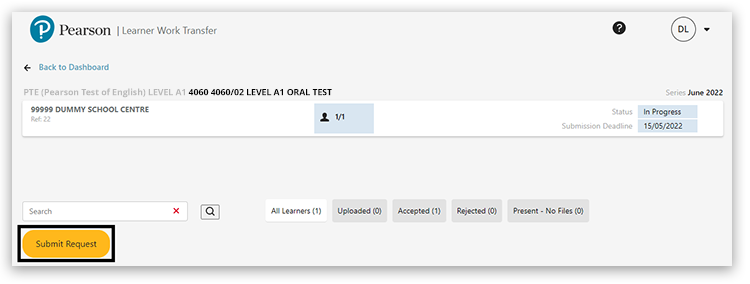
Once a request has been submitted, you will receive a confirmation message; click 'Ok' to proceed:
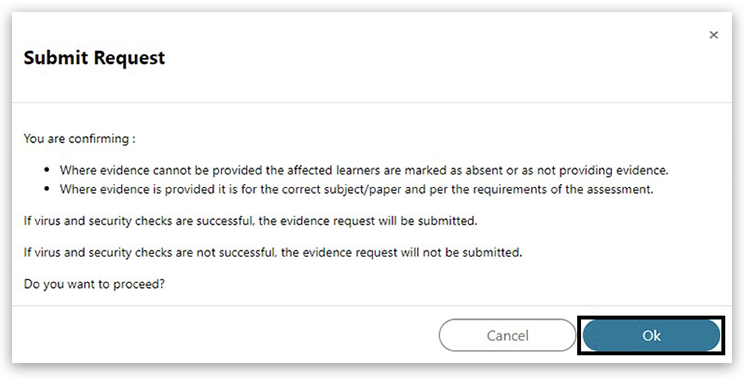
This will send the request to your assessor, and you will no longer be able to add, edit or remove evidence. The completed tab shows requests which have been submitted for assessment:
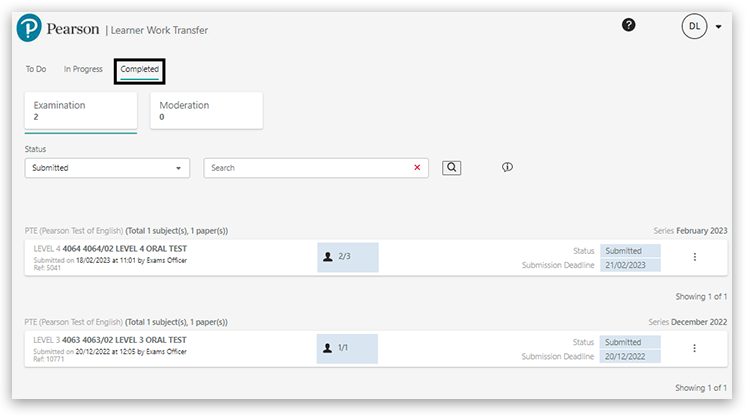
If the assessor finds that the wrong material has been uploaded, they can return the request to the centre. You should receive an email from the assessor or Pearson. This will show in the 'In Progress' tab with the status 'Returned'. You can then add or remove files before resubmitting the request:
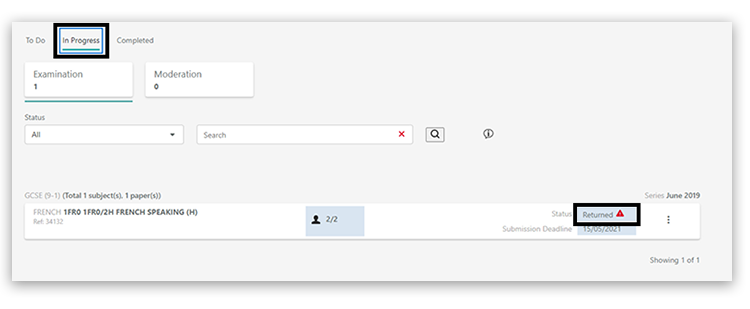
If the centre identifies incorrect documents uploaded and submitted, they will need to contact the assessor or Pearson for the request to be returned.
|
5. Linking a file to multiple learners
Use the 'Shared Files' feature to upload a file that must be shared between multiple learners. You can drag and drop files into the grey space or browse to the required file within your system:

You will see the document status of 'Uploaded':

Once the file shows as 'Accepted', you will then be able to link the learners to it. Click on the 3 vertical dots on the right of the shared files area and select 'Manage Shared Files':

Use the dropdown to select a file to see a list of available learners:

Use the checkboxes on the left to select all learners or select specific learners:
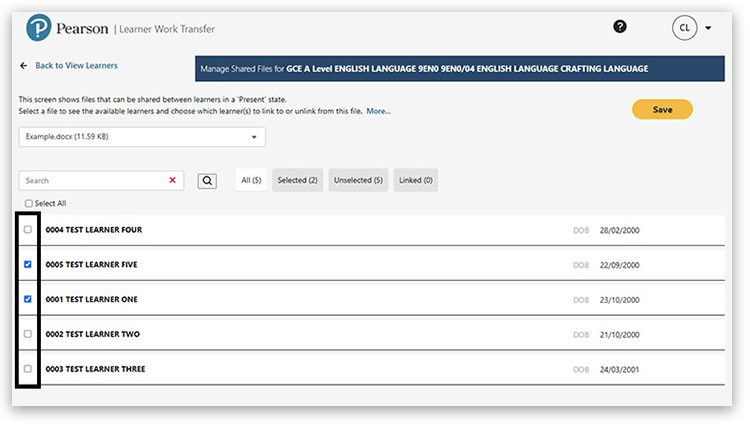
When all relevant learners have been selected, click on the 'Save' button:
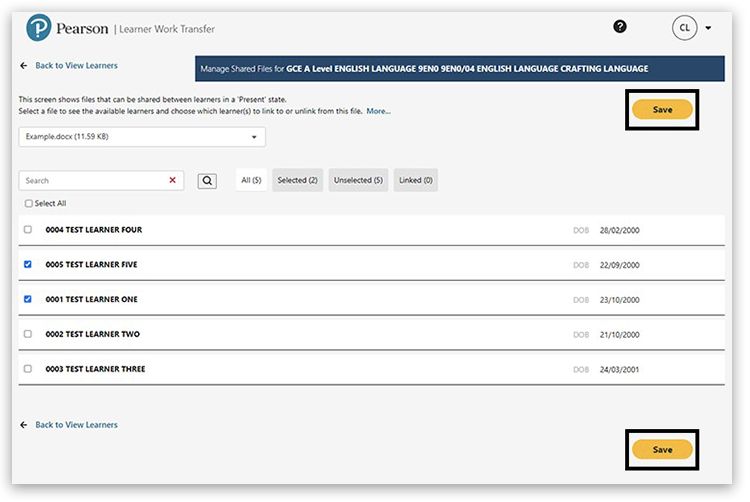
A confirmation message will be displayed at the top of the page:

Click on 'Back to View Learners' at the top or bottom of the page to return to the request:
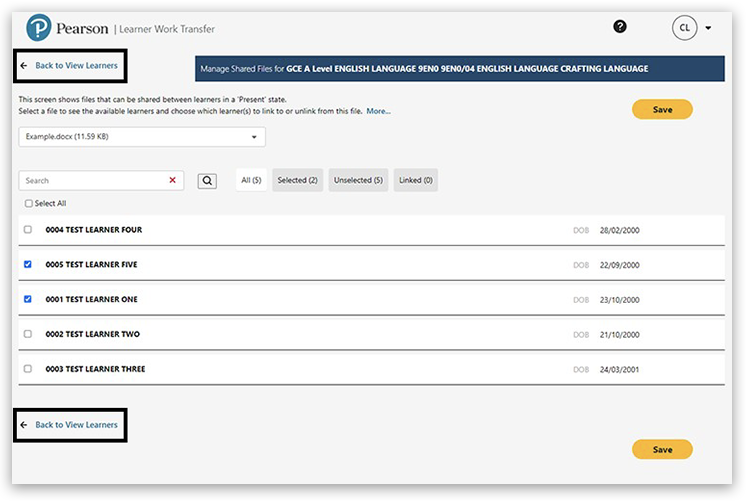
The 'shared file' icon next to the filename indicates that this file is associated with multiple learners. Clicking on this icon will display a pop-up list of the learners associated with that file:
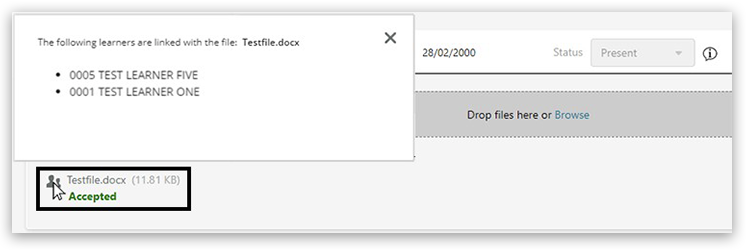
A file cannot be uploaded directly to a learner or via the shared files functionality if another file with the same name and format has already been uploaded to that card. For example, you cannot upload multiple pdfs called ‘speaking form’ to the same learner or within the shared file section. If this occurs, an error message is shown.
However, each learner can have a file called ‘speaking form’ uploaded to their card or associated with them via the shared files functionality.
You can also use this video guide (from 5 mins 55 seconds) for step-by-step instructions on how to uploading a file and linking it to multiple candidates. If uploading one form for multiple candidates, please name it with your centre number and the form name. There is no need to name a form with multiple candidate numbers if it is linked to them on LWT in this way.
|
|
Support and contact
To contact us directly, please use the Customer Support Team, select your 'Role' and 'Support type' and you will see a selection of recommended articles, If none of these contain the support you require, then select 'Submit a Case':
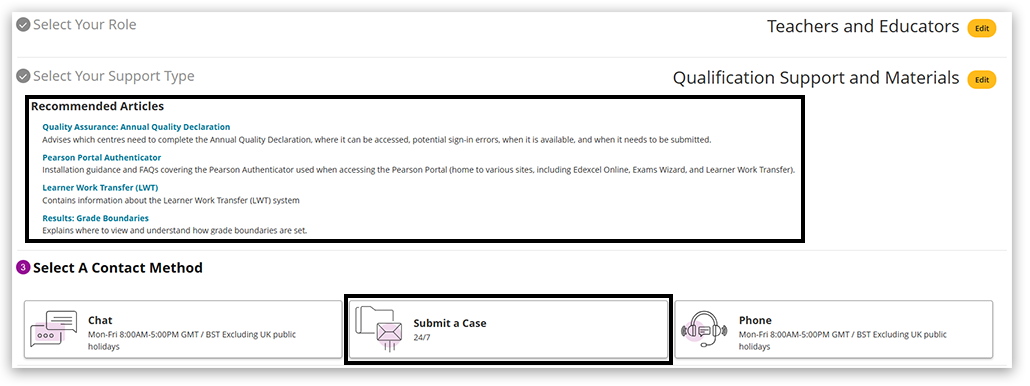
Use the request type 'Administration & Assessment of Qualifications':
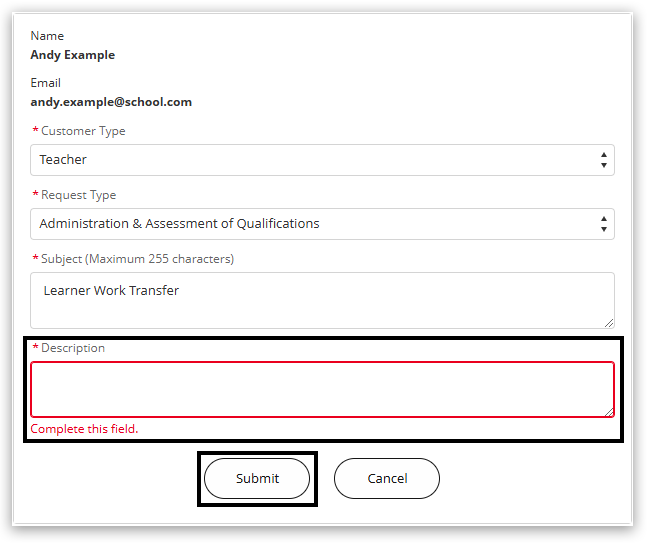
In the 'Subject' field, enter Learner Work Transfer, and in the 'Description' field, enter the qualification and subject and describe your query. Then click 'Submit'. Further detailed guidance on submitting a case record.
|
Back to Learner Work Transfer (LWT) index page. |
|
|---|



